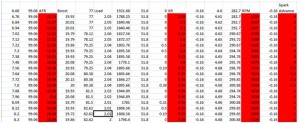Knock Detection and mitigation is a very important aspect of the control system of modern vehicles. The availability of very fast ECUs and wideband knock sensors makes it possible for the ECU to adapt the ignition timing to different fuel qualities, temperatures, boost pressures etc. to prevent damage to the engine and achieve maximum performance.
The Mazdaspeed / Mazda MPS vehicles make use of a good knock detection system that is a very good tool used for tuning as well as for maintaining safe operation of the vehicle in variable conditions.
A lot of people datalog the KR (Knock Retard) parameter and have questions regarding what it is really telling them about how their car is running and this is not just Mazdaspeed specific. Essentially the KR value is the amount of timing in degrees that the ECU is pulling from the base map once the knock sensor has picked up noise that it has interpreted as knock. Often, the interpreted knock is very much real while other times it may be something else. I want to clarify several nuances which may spike KR that are NOT caused by detonation and the timing curve.
1. Spool up KR. Here you will see a bit of KR (anything under 1.0 I just take as a “we’ve reached the efficient point” sign). This is common and should not to worry you as long as it dies down like it does here and does not exceed 2.0. Remember the ECU drops KR in steps over a certain period of time and you can see this here and in all logs. If the KR is dropping it means no more knock is detected and the ECU is returning the timing to the base table. Why is there KR in this log? Look at the BATs (Boosted Air Temperature) – they are fairly high just as the boost pressure is climbing.
2. High RPM KR that is a result of mechanical noise/shifting. In the same log over 6K RPM there is a 0.7-1.0 or so of KR creeping in. This is a sign of mechanical noise but at 0.7 it’s not something to really worry about. Then take a look at the 2.1 KR value before it goes to 0. That is where the driver let off the throttle and the motor moved in the engine bay causing mechanical noise. This is very common in this vehicle – a fast spike just as you shift or right when you let go of the throttle. This is not knock – just the engine moving around in the engine bay – don’t worry about this. You can decrease the sensitivity of the sensor in the high RPM region if the tuning tools allow you. However if it is very high KR (2-3+), you’re either indeed detonating or have a VERY noisy engine (see comment below)
If you see consistent high KR (5+ during WOT runs in this case) and it is not due to timing or during shifting this is caused by other mechanical parts. Anything from a timing chain, to injector seals, to a bent rod. So keep an eye and diagnose this instead of trying to tune around it. Below is what turned out to be KR caused by a bent rod. As you can see it ramps right up to the max 5.95 allowable in this tune at WOT and sits there regardless of timing (which drops into negative numbers).
3. Cold engine KR. When the car is not fully warmed up (even if the temperature gauge tells you it’s fine) you may experience more KR than usual going up in the RPM range or under boost. This is because the engine internals have not reached operating temperature and expansion and are just noisier. Rule of thumb is to drive the car for at least 15 minutes before doing full WOT runs … or to get an oil temperature gauge. Either way, if the car is cold, it’s best to let it warm anyways before really getting on it so this KR serves as a friendly reminder.
Part throttle KR got first generation MazdaSpeed vehicles – some insight
I have recently swapped out the ECU in our shop car for the latest part from Mazda (It’s a gen1 2008.5). This is a different part number from what came in the car and it supersedes all other ECU part numbers for gen1s (there are many). The interesting aspect is that the part throttle and warm-up KR have significantly decreased or completely disappeared with no other changes to the car. Before readings in the 5-6+ KR range were normal as the car warmed up or on the first run of the day as well as at part throttle. Now they are either at 1* KR or below. No hardware changes, no tuning changes, no weather changes, just an ECU swap.
Now how does this play into the whole KR bit? While we have access to some of the knock sensor tuning tables via COBB AccessTuner and VersaTuner, we don’t have access to the filtering algorithm (in the ECU firmware) or hardware. Remember that the knock sensor is a microphone and the ECU filters that signal to interpret knock. Mazda may have updated the hardware or algorithms responsible for this. This is further supported by the fact that the newer cars (gen2) don’t suffer from this “part throttle knock” syndrome nearly as much as the gen1s.
What does this mean? Well it means that the algorithm was perhaps overly sensitive picking up “false knock” initially and not just scaring enthusiasts but losing some efficiency at part throttle since timing was lowered. This can also put to rest some of the fears that people (mainly gen1 owners) have when they see high part throttle KR readings.





